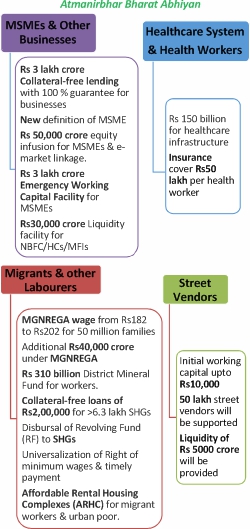|
COVID-19 and Beyond:
Corona
Virus is spreading rapidly globally. The Prime Minister of India
announce Various fiscal, monetary and macro-financial policies have been devised and guidelines issued for food, direct benefit transfer, disaster management, healthcare, labour and employment for immediate relief. Packages have been released for migrant labourers, small and medium scale enterprises, SHGs, healthcare systems, health workers, urban and rural poor citizens, women, farmers, street vendors and MGNREGA workers (KPMG, 2020). The government has launched ‘Aatmanirbhar Bharat Abhiyaan’ for building a self-reliant Indian economy through a comprehensive package of Rs 20 lakh crore, equivalent to 10% of India’s GDP. It intends to bring reforms for businesses, MSMEs, migrants, farmers, agriculture; reforms to fast-track investment clearances, upgradation of industrial infrastructure, boosting private investment in social infrastructure; reforms in healthcare, governance, in ease of doing business (India, 2020). Further, a National Employment Policy (NEP) is being designed, to ensure social and job security by formalisation of the country’s 500 million workforce including migrants. It will provide an enabling environment for new industries and enterprises to create employment opportunities and and also enhance the skills of the existing workforce to make them employable (Times, 2020). It has been experienced that due to infrastructural limitations and poor coordination among agencies, the benefits do not reach the people at the last mile for whom the interventions are done. The need of the hour is a planned monitoring and evaluation of implementation; development of methods to measure the economic, social and environmental outcomes of the measures taken in the short, medium and long term. References:
Siddharth Jain
|
 d
a nation-wide lockdown on 24th March 2020, which was extended three
times to curb the spread of COVID. Though, people learnt preventive
practices during this time, but it halted all economic and social
activities. This impacted organised & unorganised sectors in terms of
loss to domestic markets, loss of jobs, reverse migration of labourers
to their native villages and loss to the country’s economy. Then the
government allowed graded relaxation in economic activities from 20th
April 2020 and gradually lifted the lockdown.
d
a nation-wide lockdown on 24th March 2020, which was extended three
times to curb the spread of COVID. Though, people learnt preventive
practices during this time, but it halted all economic and social
activities. This impacted organised & unorganised sectors in terms of
loss to domestic markets, loss of jobs, reverse migration of labourers
to their native villages and loss to the country’s economy. Then the
government allowed graded relaxation in economic activities from 20th
April 2020 and gradually lifted the lockdown.